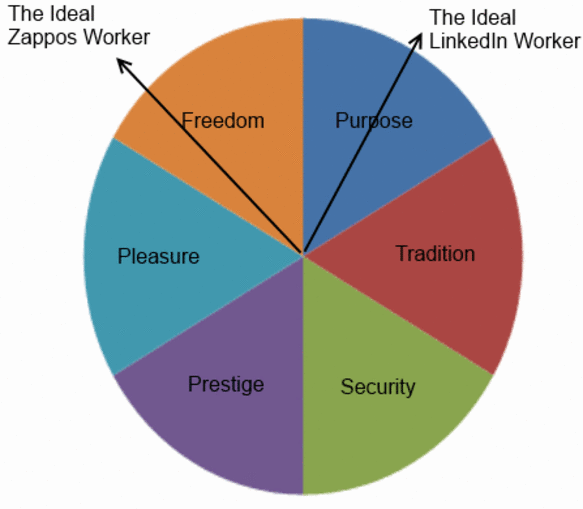Just as the internet and information technology has made matching in other domains (e.g. classified ads or home buying) more efficient, values based matching in the labor market is bound to be a problem tackled by data science teams at online companies in the near future.
I often find myself at data conferences with members of LinkedIn’s data team, which is one of the most visible and productive, given the wealth of data they have to mine. It may seem that what they do and what values researchers do are separate worlds, but as I argued in my2012 SXSW talk, there is likely to be a convergence. Big data is merely a tool that inevitably will be used to answer the questions we care about, and for those of us with first world problems where crime is going down, war is less of an issue, and obesity is a bigger problem than hunger, the questions we increasingly ask tend to be more existential. It is only natural that we use the tools of the age (data) to answer the questions of the age, like how we can live a meaningful life.
Unlike some who are more dogmatic in their belief, I don’t believe that data can tell you what a meaningful life is or how you should live. In short, moral psychology cannot tell you what ought to be…but it can tell you what is. For example, at Zenzi, we have been working on describing the narratives that people of different value types tend to resonate with. I can’t tell you whether action or comedy movies are better, but I can provide a probabilistic fit between a person’s value orientation and the kinds of stories that they are likely to enjoy.
Similarly, companies and prospective employees are looking for such fits as well. Zappos wants people whose values tend toward the unconventional. LinkedIn wants people who will put their members’ first. In moral psychology terms, Zappos is looking for individuals who are high on traits like openness to experience and stimulation, while LinkedIn might be looking for individuals who are more self-transcendent in terms of putting others (their members) first.
These values are measurable both with self-characterizations and endorsements, just like LinkedIn skills, but also through more subtle means such as music tastes or use of certain words. Further, following on work by Shalom Schwartz, values can be organized as oppositional (see above graph using Zenzi’s value typology which is based on Schwartz’s work), so that self-presentation effects (e.g. “I’m high on all values!”) can be mitigated. In this way, companies and employees may potentially be able to find employment matches that are not just a job, or even a career, but are closer to a calling, leading to happier and more productive employees.
Anyone who solicits employees knows that resumes all start to blend together at some point. The employment market needs more nuance, more subtlety, and more data to help create better matches. I don’t know if LinkedIn or some other organization will lead the charge, but I’m confident that this type of values based matching will indeed be part of the future of human resources recruiting, and it already is part of many forward thinking organizations’ processes. Just as the internet and information technology has made matching in other domains (e.g. classified ads or home buying) more efficient, values based matching in the labor market is bound to be a problem tackled by data science teams at online companies in the near future.
